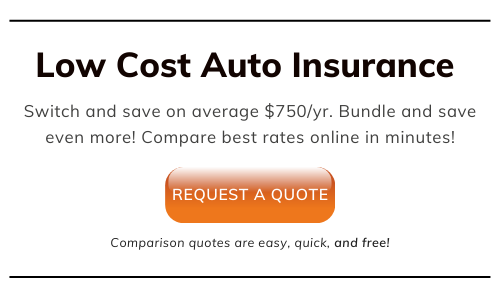Cheapest Car Insurance in Ohio
Free Insurance Comparison
Compare Quotes From Top Companies and Save
Secured with SHA-256 Encryption
Kristen Gryglik
Licensed Insurance Agent
Kristen is a licensed insurance agent working in the greater Boston area. She has over 20 years of experience counseling individuals and businesses on which insurance policies best fit their needs and budgets. She knows everyone has their own unique needs and circumstances, and she is passionate about counseling others on which policy is right for them. Licensed in Massachusetts, New Hampshire,...
Licensed Insurance Agent
UPDATED: Dec 4, 2023
It’s all about you. We want to help you make the right coverage choices.
Advertiser Disclosure: We strive to help you make confident insurance decisions. Comparison shopping should be easy. We are not affiliated with any one insurance provider and cannot guarantee quotes from any single provider.
Our insurance industry partnerships don’t influence our content. Our opinions are our own. To compare quotes from many different insurance companies please enter your ZIP code on this page to use the free quote tool. The more quotes you compare, the more chances to save.
Editorial Guidelines: We are a free online resource for anyone interested in learning more about insurance. Our goal is to be an objective, third-party resource for everything insurance related. We update our site regularly, and all content is reviewed by insurance experts.
The best way to find the cheapest car insurance in Ohio is to shop around.
By analyzing quotes, policies, reviews, and ratings from several top companies, you can discover not only which company has the best rate, but also which one provides the most comprehensive coverage, the best service, and the fastest claims process.
When it comes to building policies and calculating rates, insurance providers consider several important elements.
While your age, gender, driving record, and the vehicle you drive are all considered, where you live is just as important to your insurer.
Once you understand how your geographic location affects your auto insurance premiums, it should be much easier to determine if the rates you’re being quoted are fair. Perhaps the most important factor, though, is the car you drive.
Cheapest Car Insurance in Ohio
Here are the top providers of the cheapest car insurance in Ohio:
Progressive

The company is famous for memorable commercials featuring “Flo,” as well as its Name Your Price Tool, which gives drivers the chance to build a policy at a rate they can afford.
Learn More: Progressive Car Insurance Review
Allstate

It started as a small U.S. auto insurance company in 1931 and has since expanded to serve customers worldwide with home, auto, life, and commercial insurance options.
The company is well known for its wide range of discounts, including one for safe drivers who use Allstate’s Drivewise® app.
Learn More: Allstate Auto Insurance Review
USAA

It provides coverage for all types of vehicles including motorcycles, cars, trucks, boats, and RVs.
Learn More: USAA Car Insurance Review
Enter your ZIP code below to view companies that have cheap insurance rates.
Secured with SHA-256 Encryption
Average Cost of Car Insurance in Ohio
Taking a look at the average cost of car insurance for drivers throughout Ohio is a good way to ensure you’re getting fair the quotes.
When comparing the average cost of insurance in Ohio against the national average, you can see that the price in Ohio is on the lower end of the spectrum.
| Average Cost of Car Insurance in Ohio | $838.00 |
| National Average Cost of Car Insurance | $889.01 |
What Factors Affect The Cost of Car Insurance In Ohio?
Outside of your vehicle and driving history, several factors affect your insurance rates, including conditions specific to the place you live.
Traffic density, crime rates, population statistics, and disposable income in Ohio are just a few of these variables.
Traffic Conditions in Ohio
When insurance providers are calculating the price of your policy, they almost always take into account the traffic density and accident rates in your geographic area.
It’s important to remember that state averages don’t always accurately reflect the traffic conditions in metropolitan areas. Cities such as Cleveland and Cincinnati have higher traffic density and fatal accident rates than rural areas throughout Ohio.
According to the National Association of Insurance Commissioners 2017 report on traffic density, Ohio has a traffic density (number of miles traveled by all registered vehicles in the state against miles of highway throughout the state) of 917,657, considerably higher than the national average of 724,348.
When comparing vehicle miles traveled per each registered vehicle in the state, the result is 11,222, slightly below the national average of 12,010. Fatal accidents in Ohio occur at a rate of 0.1 per 1,000 vehicles, just a little below the national average of 0.13 per 1,000 vehicles.
While living in Ohio’s rural and less densely populated areas may save you on insurance based on lower than average mileage and fatal accident statistics, those living in the state’s metropolitan areas should be prepared for higher insurance premiums, as traffic density and accident rates are generally higher in cities.
Vehicle Theft Rates
According to the Insurance Information Institute (III), Ohio is in the top 10, ranking eighth for the highest number of auto theft rates. In Ohio, an estimated 729 auto thefts occurred per 100,000 residents in 2016, according to the FBI. This rate is substantially higher than the national average of 236 auto thefts per 100,000 residents.
The National Insurance Crime Bureau’s Hot Wheels Report indicates that the following vehicles are at a higher risk for being stolen:
- 2004 Ford Pickup
- 1999 Chevrolet Pickup
- 2004 Honda Accord
- 2008 Chevrolet Impala
- 2012 Honda Civic
- 2005 Chevrolet Malibu
- 2007 Toyota Camry
- 2000 Jeep Cherokee/Grand Cherokee
- 2003 Dodge Caravan
- 2010 Toyota Carolla
Shopping for a vehicle that has lower theft rates may help you to qualify for a lower insurance rate.
Population Density
While population density doesn’t have a direct effect on insurance rates, when areas have a higher population density it means there are more vehicles on the roads in that specific area.
More vehicles mean higher theft and accident rates, which equates to greater risk for insurance companies and higher insurance premiums for policyholders.
Throughout the country, the average population density is 95 person per square mile, while the state of Ohio has a much higher population density of 283 persons per square mile.
Population density in rural areas is considerably lower than that of metropolitan areas, therefore, living outside the city may result in a lower insurance rate.
Disposable Income
Average disposable income for residents across Ohio is another factor that indirectly influences insurance rates. Areas with more disposable income usually have a higher volume of expensive vehicles, meaning that insurance companies face a higher risk.
This increased exposure by the insurance carriers results in drivers paying higher rates for their auto insurance.
According to the NAIC, the per capita disposable income per person in Ohio in 2014 was $37,490, which is slightly below the countrywide average of $40,859.
Keep in mind that this is a state average, and metropolitan areas such as Cleveland and Cincinnati may have higher average disposable incomes.
What is Mandatory for Car Insurance in Ohio?
Throughout most states, including Ohio, there are minimum auto insurance requirements. According to the Ohio state insurance laws, all vehicles and drivers must have liability coverage.
Each state sets minimum coverage amounts that all drivers are required to carry. In Ohio, these minimums are as follows:
Liability Insurance
- $25,000 for injuries per person
- $50,000 for total injuries per accident
- $25,000 for property damage
When registering their vehicles, drivers must sign an agreement to carry valid liability insurance. Proof of insurance must be presented at the scene of an accident, when an officer of the law requests it, or upon request during random BMV checks.
Failure to present proof of insurance may result in loss of driving privileges, revocation of license plates or registration, or mandatory SR-22 filing, which is an expensive insurance report that is filed by your insurance carrier providing a guarantee that you have valid insurance.
Enter your ZIP code below to view companies that have cheap insurance rates.
Secured with SHA-256 Encryption
How to Reduce the Cost of Your Car Insurance in Ohio
Buying car insurance is an important way to protect yourself, your property, and your finances from expensive repairs and medical bills should an accident occur.
While car insurance can seem costly, it doesn’t always have to be. Once you’ve found the best car insurance in Ohio, use the following tips by the Insurance Information Institute:
- Increase your deductible
- Reduce your coverage on older vehicles
- Bundle all of your insurance policies
- Maintain a high credit score
- Reduce your mileage, if possible
Most insurance providers offer discounts that reward drivers for things such as good driving habits and paying their policy in full.
While shopping for insurance, make sure to have the following information on hand so that you can get an accurate quote that includes all discounts you’re eligible for:
- Vehicle information such as the make, model, year, VIN, usage habits, safety features and anti-theft devices for all vehicles on your policy
- Personal information for all drivers in your household, including school grades for any teen drivers
- Household information, including your complete address and parking details, an estimate of the assets you’d like coverage for, and your budget
What Can Increase the Cost of Your Car Insurance in Ohio?
Several elements can contribute to an increase in your insurance rates. While some of these factors may be out of your control, there are steps you can take to minimize the effects they have on your rates.
- Safety Rating and Potential to Cause Damage: The National Highway Traffic Safety Administration and the Insurance Institute for Highway Safety perform safety and crash tests on hundreds of vehicles each year and assign them ratings that are made available to the public. Choosing a vehicle that has performed well in these tests can lead to lower insurance rates.
- Driver Age: Both teen and senior drivers are usually associated with a higher risk of traffic accidents and driving violations, meaning the premiums they pay are considerably higher than average. However, the successful completion of a defensive driving course can help lower these particular demographics obtain lower rates.
- Driving Record: Drivers who violate traffic laws are subject to higher insurance rates. Depending on the incident and its severity, the consequences of violating these laws can range from a small fine to the suspension of your license or even jail time. Regardless of the consequences, you’ll most likely see an increase in your insurance rates after an infraction. Obeying laws and driving cautiously can help keep your rates from increasing.
Shopping for Cheap Car Insurance In Ohio

Comparing quotes, coverage options, financial strength, and ratings and reviews from at least three companies is the most reliable way to find the cheapest car insurance in Ohio.
Researching can help you avoid purchasing insurance from a company that may not offer you sufficient coverage in the event of an accident, or that provides poor service or a slow, unreliable claims process.
Of course, the easiest way to find reliable insurance is to shop with top insurance companies above.


